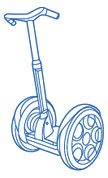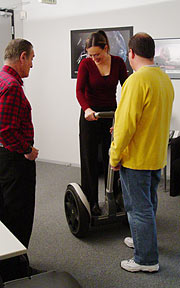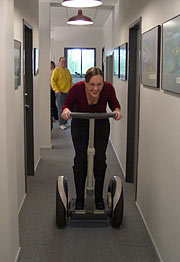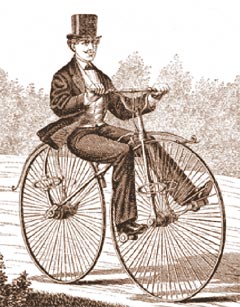|
...possibly the coolest way to travel modest distances... |
||
|
Check out Chapter 2 of GlideWalk for more detail on the gliding experience. Chapter 3 contains some relevant safety tips that could prolong your life.
Page: |
A. Balancing and gliding are intuitive. We could probably talk about the experience ad infinitum--and will--but anticipation is nothing compared to actually doing it. People who never considered trying it before may even have an advantage. A lack of preconceived notions can be a good thing. Case in point: In a recent SegwayLA meeting, the one person who showed up who had no ideas about the HT was our meeting facilitator, Lori. (right) So, naturally we gave her the front of the demo line. She followed owner Tom Johnson's instructions and within three minutes was breaking the sound barrier** with the HT.
Her lack of preconceived notions may even have helped. Of course, now we will never know, since once you learn the beast, your first time is over, never to be repeated again. If Lori had been thinking about this for a while, would her first experience have been different? Once your body "gets it," you have learned something at such a fundamental level that you will not have to learn it again. Within a few minutes, you will be breaking the sound barrier, too**. **or whatever barrier you break at 6 mph. |
|
|
Q! Come on, can't you get hurt on these? A. Out of the three safest activities on Earth, a trio of them are things that can hurt you. [#2, Blinking: D'oh! Piece of grit!] ...and don't eMail me about the people who die in their sleep... It doesn't take a rocket scientist to get hurt taking a shower. Astronaut and rocket scientist John Glenn did. So of course you can get hurt on the HT. Plus, you can be dumb or inattentive at any moment in your life. It's in the Constitution: "...you have the right to remain stupid. If you are not stupid enough, the court will appoint..." Maybe I'm misquoting. That's not the real issue with a machine that is doing its darndest to keep you in control, give you the power of extended abilities and deliver you and itself safely miles away in a few minutes. It's worth remembering that the guy who dreamed up this gizmo is an inventor of life saving, life-extending, life-enhancing equipment first. Who would you rather trust; Razor or Kamen? |
||
|
 |
Q! How fast do they crash into people? A. Trick question. But indicative of how some people think of these, never having experienced one to the point of proficiency (two hours gliding). In Real Life--the one that is being lived by actual humans on HTs--crashing into people is exceedingly rare. You would have to be stoned, crazy or momentarily inattentive to do it. Not that these practices are outside the realm of human activity, mind. But let's assume everything went horribly wrong... The top speed is 12.5 miles per hour. You can't run that fast for very long (4 Minute Milers excepted at a 15 mph average), but it's slower than driving legally through a school zone. Data-coded keys for learning with the HT limit its performance to 6 and 8 mph depending on which one you use. The yellow key, with its ability to propel you along the sidewalk at jogging speed, is appropriate for city sidewalks in the experience of many. Segway even names this the "Sidewalk Key" in their instructions. As people gain experience, the red key (Open Environment Key) becomes the popular option for the experienced glider. Remember, every key allows slow operation. Stopping, balancing, waiting for a traffic light and creeping along behind a slow walker is equally easy with all keys. The keys are a security device, too, and are intimately connected to complex codes burned into the central computer--without the right key, the entire rig becomes an inert door stop. The CIA couldn't activate it. You can't "hot-wire" the thing. Stealing one without its key will do you NO good. Hey! I want this security system for my laptop! The computer on my car often tells me my urban average speed was about 22-24 mph on the street. And that includes the zoomy parts. With curbs, traffic lights and dawdling, I don't think the 'average' speed of the HTs is going to top 5 mph. But if you wanted to, you might be able to travel two miles in ten minutes down a long runway. Just watch out for the 747s. If you decide to crash into people, you could do it. Bad idea, though. HT drivers are not wearing a seat belt, there's no air bag, and exiting one at full speed will likely twist or break something on the driver. The only public occasion for someone intentionally smashing an HT into something was San Francisco ban advocate Bruce Lee Livingston who --within two minutes of first piloting one-- was "demonstrating" how a motivated pathological idiot could do harm with the HT by banging it intentionally into the local furniture. Great: two minutes experience and Bruce becomes a Test Pilot proving what the criminally insane can do with an HT? Good going, Brucie. You proved your point and revealed your inner child all at the same time. Stay away from my car. Moreover, don't get on an airplane I'm in. >> Hint to Bruce's party posse: Do NOT let him be the 'designated driver.' People trip when running. Didn't you see that sign at the pool? People fall on the pavement all the time (Especially in The City Of Hills). And they break bones doing it, too, without an HT. Check the San Francisco ER records. How many bone-breaking falls would the HT in San Francisco have prevented? We may never know. But with broken hip mortality at about 20%, "how many lives might it have saved in San Francisco?" is the better question. When you glide along --in exquisite control of your moves and clearances-- a different "movement ethic" takes over. You gauge things according to your senses and you accommodate the local conditions. That's assuming an enlightened glider who adopts a responsible attitude and isn't slamming somebody else's HT into the furniture.
Standing still and backing up are not available instantly on a bike. You don't stop a bike with the ease of walking and suddenly halting in place. I like bicycles, but mine hasn't called to me in over 3000 days... With the HT, you move the way you walk. Only amplified into a zone of response that your human movement/brain system is fully capable of enclosing after a minimum of practice. It would seem that Mother Nature did a great job of engineering us. We drive cars, land planes, ice skate, ski, and now, glide; all with the software in our brains that was designed for walking and occasionally running. It's as if She over-engineered us, which is true. She engineered us to survive in a world that demands responses greater than walking and jogging. Visit the Cirque du Soleil for an education in the possibilities we are born into. Nice job, Ma. Nice job, Cirque. Nice job of adapting to Ma's design, too, Dean. |
 |
|
|
||

 Perhaps I exaggerate, but she clearly learned the
entire basic skill set of balance, steering, motion, stopping
and trying new ideas in no time flat.
Perhaps I exaggerate, but she clearly learned the
entire basic skill set of balance, steering, motion, stopping
and trying new ideas in no time flat. A bicyclist adopts a bicycle movement ethic intuitively,
too, adjusting for the linear thrust of the bike and moving at
speeds that are appropriate to conditions. But the bicyclist
actually has much less control, because the trick is to make
up side to side tipping by steering into (under) the tip--and
that requires forward speed, or it doesn't work at all.
A bicyclist adopts a bicycle movement ethic intuitively,
too, adjusting for the linear thrust of the bike and moving at
speeds that are appropriate to conditions. But the bicyclist
actually has much less control, because the trick is to make
up side to side tipping by steering into (under) the tip--and
that requires forward speed, or it doesn't work at all.